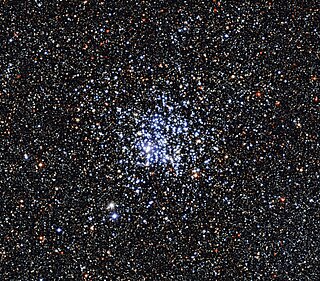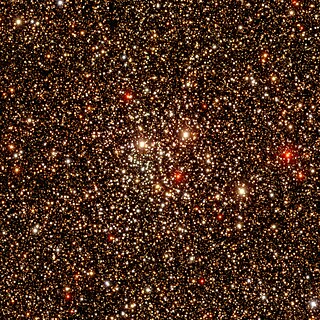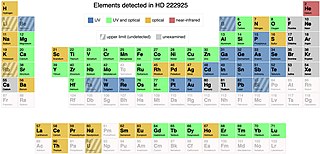
HE0107-5240 is an extremely metal-poor Population II star, located roughly 36000 light-years away from Earth. It is one of the most metal-poor stars known in our Galaxy, with a metallicity [Fe/H] = −5.2±0.2; i.e. it has just 1/160000 of the metal that the Sun has. Because of its very low metallicity, it is believed to be one of the earliest Population II stars to have formed. If so, then it is also very old, with an age of roughly 13 billion years. Because the star is not completely metal-free, it does not belong to the first generation of stars. These stars converted the pristine hydrogen, helium, and lithium formed by the Big Bang into heavier elements, such as carbon, oxygen, and metals.
BPS CS31082-0001, named Cayrel's Star, is an old Population II star located in a distance of 2.1 kpc in the galactic halo. It belongs to the class of ultra-metal-poor stars, specifically the very rare subclass of neutron-capture enhanced stars. It was discovered by Tim C. Beers and collaborators with the Curtis Schmidt telescope at the Cerro Tololo Inter-American Observatory in Chile and analyzed by Roger Cayrel and collaborators. They used the Very Large Telescope (VLT) at the European Southern Observatory in Paranal, Chile for high-resolution optical spectroscopy to determine elemental abundances. The thorium-232 to uranium-238 ratio was used to determine the age. It is estimated to be about 12.5 billion years old, making it one of the oldest known.

Delta Pavonis, Latinized from δ Pavonis, is a single star in the southern constellation of Pavo. It has an apparent visual magnitude of 3.56, making it a fourth-magnitude star that is visible to the naked eye from the southern hemisphere. Parallax measurements yield an estimated distance of 19.89 light-years from Earth. This makes it one of the nearest bright stars to the Solar System. It is approaching the Sun with a radial velocity of −23.5 km/s, and is predicted to come as close as 17.8 light-years in around 49,200 years.

The Wild Duck Cluster is an open cluster of stars in the constellation Scutum. It was discovered by Gottfried Kirch in 1681. Charles Messier included it in his catalogue of diffuse objects in 1764. Its popular name derives from the brighter stars forming a triangle which could resemble a flying flock of ducks. The cluster is located just to the east of the Scutum Star Cloud midpoint.

HE 1327-2326, discovered in 2005 by Anna Frebel and collaborators, was the star with the lowest known iron abundance until SMSS J031300.36−670839.3 was discovered. The star is a member of Population II stars, with a solar-standardised iron to hydrogen index [Fe/H], or metallicity, of −5.4±0.2. The scale being logarithmic, this number indicates that its iron content is about 1/250000 that of the Earth's sun. However, it has a carbon abundance of roughly one-tenth solar, and it is not known how these two abundances can have been produced/exist simultaneously. Discovered by the Hamburg/ESO survey for metal-poor stars, it was probably formed during an age of the universe when the metal content was much lower. It has been speculated that this star is part of the second generation, born out of the gas clouds which were imbued with elements such as carbon by the primordial Population III stars.

18 Scorpii is a solitary star located at a distance of some 46.1 light-years from the Sun at the northern edge of the Scorpius constellation. It has an apparent visual magnitude of 5.5, which is bright enough to be seen with the naked eye outside of urban areas. The star is drifting further away with a radial velocity of +11.6.
BPS CS22892-0052 is an old population II star located at a distance of 4.7 kiloparsecs in the Milky Way's galactic halo. It belongs to a class of ultra-metal-poor stars, specifically the very rare subclass of neutron-capture (r-process) enhanced stars. It was discovered by Tim C. Beers and collaborators with the Curtis Schmidt telescope at the Cerro Tololo Inter-American Observatory in Chile. Extended high-resolution spectroscopic observations since around 1995 allowed observers to determine the abundances of 53 chemical elements in this star, as of December 2005 only second in number to the Sun.
BD+17°3248 is an old Population II star located at a distance of roughly 968 light-years in the Galactic Halo. It belongs to the class of ultra-metal-poor stars, especially the very rare subclass of neutron-capture (r-process) enhanced stars.

Nu Phoenicis is a F-type main-sequence star in the southern constellation of Phoenix. It is visible to the naked eye with an apparent visual magnitude of 4.95. This is a solar analogue, meaning its observed properties appear similar to the Sun, although it is somewhat more massive. At an estimated distance of around 49.5 light years, this star is located relatively near the Sun.

HE 1523-0901 is the designation given to a red giant star in the Milky Way galaxy approximately 9,900 light years from Earth. It is thought to be a second generation, Population II, or metal-poor, star ([Fe/H] = −2.95). The star was found in the sample of bright metal-poor halo stars from the Hamburg/ESO Survey by Anna Frebel and collaborators. The group's research was published in the May 10, 2007 issue of The Astrophysical Journal.
HR 4523 is a binary star system that is located in the northeastern part of the Centaurus constellation, at a distance of about 30.4 light-years from the Solar System. The larger member of the system is a G-type star that is smaller than the Sun but of similar mass. It has a common proper motion companion that was discovered by W. J. Luyten in 1960. This M-type star appears to be in a wide orbit around the primary at a current separation of about 211 astronomical units (AU),. By comparison, Neptune orbits at an average distance of 30 AU.

HD 47536 is a single star in the southern constellation of Canis Major. It has an orange hue and is dimly visible to the naked eye with an apparent visual magnitude of +5.25. The star is located at a distance of approximately 408 light years from the Sun based on parallax. It is drifting further away with a radial velocity of 80 km/s.
HD 171028 is a star with an exoplanet companion in the equatorial constellation of Ophiuchus. With an apparent visual magnitude of 8.3, it is too faint to be readily visible with the naked eye. Unlike most planet-harboring stars, it does not have a Hipparcos number. The star is located at a distance of approximately 365 light years from the Sun based on parallax, and is drifting further away with a radial velocity of +13.5 km/s.
HD 122563 is an extremely metal-poor red giant star, and the brightest metal-poor star in the sky. Its low heavy element content was first recognized by spectroscopic analysis in 1963. For more than twenty years it was the most metal-poor star known, being more metal-poor than any known globular cluster, and it is the most accessible example of an extreme population II or Halo star.
HD 181720 is star with an orbiting substellar companion in the southern constellation of Sagittarius. It is located at a distance of 196 light years from the Sun based on parallax measurements, but is drifting closer with a radial velocity of −45.4 km/s. The star has an absolute magnitude of 4.10, but at that distance it has an apparent visual magnitude of 7.84, which is too faint to be seen with the naked eye. It shows a high proper motion, traversing the celestial sphere at an angular rate of 0.444 arcsec yr−1.
HD 190984, also known as HIP 99496, is a star located in the southern circumpolar constellation Pavo, the peacock. It has an apparent magnitude of 8.76, making it readily visible in small telescopes, but not to the naked eye. Based on parallax measurements from the Gaia spacecraft, the object is estimated to be 486 light years away from the Solar System. It appears to be receding with a heliocentric radial velocity of 20.3 km/s.

HD 114613 is a fifth magnitude yellow subgiant that lies 66.7 light-years away in the constellation of Centaurus. The star may be host to a long-period giant planet.
39 Leonis is the Flamsteed designation for a star in the zodiac constellation of Leo. It has an apparent visual magnitude of 5.90, so, according to the Bortle scale, it is faintly visible from suburban skies at night. Parallax measurements show an annual parallax shift of 0.0449″, which is equivalent to a distance of around 72.6 ly (22.3 pc) from the Sun.

NGC 4815 is an open cluster in the constellation Musca. It was discovered by John Herschel in 1834. It is located approximately 10,000 light years away from Earth.

HD 222925 is a horizontal branch star about 1,470 light years away in the southern constellation Tucana. It is magnitude 9, far below naked-eye visibility. It is an Ap star, a type of chemically peculiar star with an over-abundance of certain metals in its spectrum.










